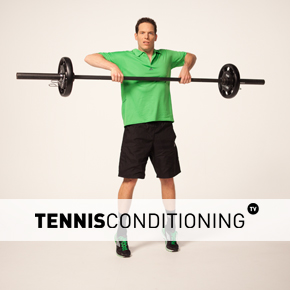The High Pull is a compound exercise to improve the synergy of the neuro-muscular system, explosiveness of hip extensor musculature while transitioning into shoulder shrug, body control & coordination, flexibility as well as improving skill & balance foundation for complex movements.
Note: If the athlete has flexibility issues, a stance wider than shoulder-width is warranted.
How to Progress
If you use additional weights…make sure you use appropriate resistance so you can control the action throughout the entire range of motion. Otherwise you defeat the purpose of the exercise.
Very often, people use too much resistance and they become sloppy. Especially when it comes to maintaining core stability repetitively.
Also, don’t just progress with adding more weight. First, maximize the speed while maintaining perfect form.
High Pull Description
- Position barbell hip level on the rack; add resistance (plates) and attach safety clips
- Use a pronated grip (palms facing down) and place hands shoulder-width apart on the bar
- Lift barbell off the rack; take a few steps back and position barbell on the floor
- Take an athletic stance; stand straight, feet are shoulder-width apart; knees slightly flexed; toes point slightly outward (10˚-20˚)
- Assume deadlift starting position; flex the transverse abdominis (abs) before moving the barbell; maintain neutral spine and head position; look forward
- 1st pulling phase; extend hips and knees in controlled fashion; maintain neutral spine position (push chest out and scapulae [shoulder blades] together); maintain neutral head position (look forward)
- Once barbell moves past the knees 2nd pulling phase occurs; explosively extend the hips and simultaneously jump vertically (plantar flexion) while shrugging the shoulders and flexing the elbows while abducting shoulders to 90˚ (upright row); barbell remains close to the body and reaches sternum (~ nipple) level; elbows point sideways
Targeted Musculature
- Hamstrings
- Glutes
- Quadriceps
- Calves (gastrocnemius, soleus)
- Shoulder Girdle (Traps & Levator Scapula)
- Deltoids

